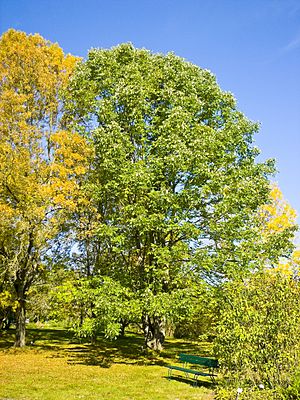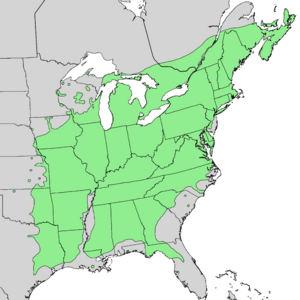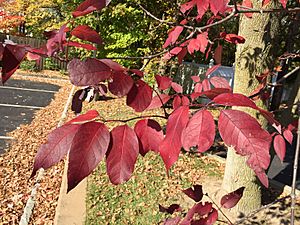White ash facts for kids
Quick facts for kids White ash |
|
|---|---|
 |
|
| Conservation status | |
| Scientific classification | |
| Genus: |
Fraxinus
|
| Species: |
americana
|
 |
|
| Natural range of Fraxinus americana | |
| Synonyms | |
|
Synonymy
Aplilia macrophyla (Hoffmanns.) Raf.
Calycomelia acuminata (Lam.) Kostel. Calycomelia alba (Marshall) Kostel. Calycomelia americana (L.) Kostel. Calycomelia biltmoreana (Beadle) Nieuwl. Calycomelia epiptera (Michx.) Kostel. Calycomelia juglandifolia (Lam.) Kostel. Calycomelia pistaciifolia Nieuwl. Calycomelia viridis (Bosc) Kostel. Fraxinoides alba (Marshall) Medik. Fraxinus acuminata Lam. Fraxinus alba Marshall Fraxinus albicans Buckley Fraxinus biltmoreana Beadle Fraxinus canadensis Gaertn. Fraxinus carolinensis Wangenh. Fraxinus caroliniana Willd. 1806 not Mill. 1768 Fraxinus curtissii Vasey Fraxinus discolor Muhl. Fraxinus epiptera Michx. Fraxinus glauca Raf. Fraxinus grandifolia Raf. Fraxinus juglandifolia Lam. Fraxinus macrophylla Hoffmanns. Fraxinus novae-angliae Mill Fraxinus villosa Dum.Cours. Fraxinus viridis Bosc Leptalix acuminata (Lam.) Raf. Leptalix alba (Marshall) Raf. Leptalix epiptera (Michx.) Raf. Leptalix glauca Raf. Leptalix grandifolia Raf. Leptalix juglandifolia (Lam.) Raf. Leptalix viridis (Bosc) Raf. Ornanthes americana (L.) Raf. Ornus americana (L.) Bosc |
|
The White Ash, also called American Ash, is a type of ash tree. It grows naturally in eastern and central North America. You can find it in forests from Nova Scotia in Canada all the way south to northern Florida and southwest to eastern Texas in the United States.
Sometimes, you might find small groups of White Ash trees in places like western Texas, Wyoming, and Colorado. It has also started growing in Hawaii. The United States has about 8 billion ash trees. Most of these are either White Ash or Green Ash trees.
Contents
What Makes White Ash Special?
The name "White Ash" comes from the light, almost white color on the underside of its leaves. It looks a lot like the Green Ash, which can make them hard to tell apart. However, White Ash leaves are much lighter on the bottom than on top. Also, the outer bark on its twigs might be flaky.
Green Ash leaves have a similar color on both sides, and their twigs are smoother. In autumn, White Ash leaves turn bright yellow or red. White Ash trees usually grow in forests. They often grow next to sugar maple trees. Green Ash trees, however, are often found near rivers or in areas that have been disturbed.
Leaf and Twig Details
White Ash leaves are "compound," meaning each leaf has several smaller leaflets. A White Ash leaf usually has 7 leaflets. Other ash trees might have a different number.
Like some other trees, the White Ash is dioecious. This means that male flowers grow on one tree, and female flowers grow on a different tree.

How White Ash is Used
White Ash is one of the most useful trees. People grow it in many places because there is a high demand for its wood. The wood is white, strong, and has a straight grain. It is also quite heavy.
Wood Uses
This wood is a top choice for making baseball bats and handles for tools. It's also great for making furniture and wood floors. Woodworkers mainly use it for things inside buildings because it doesn't last long if it's in contact with wet ground. It's even used to make lobster traps. Since the 1950s, it has become a popular wood for making solid electric guitar bodies. You can also make a good longbow from White Ash wood if you work it properly.
Planting and Colors
White Ash is not planted as often as Green Ash in cities. This is because it prefers quiet forest areas away from city pollution and packed-down soil. However, people sometimes plant it for its amazing autumn colors. Its leaves turn bright orange and red, while other ash trees usually turn a uniform yellow.
There is a special type called "Autumn Purple" or "Junginger." This wild White Ash was chosen for its beautiful purple leaves in autumn. It became very popular for landscaping after it was introduced in 1956.
Importance for Wildlife
North American ash trees are very important for North American frogs. The leaves that fall from ash trees are a key food source for tadpoles in ponds and puddles. Other trees, like red maple, are not as good for tadpoles. This means that if ash trees disappear, frogs might not survive as well or grow as big.
Ash leaves are good for frogs because they don't have many tannins. Tannins are chemicals that can make leaves harder to digest. Ash trees from other parts of the world often have more tannins. North American ash trees also provide important homes and food for many other native animals.
The Emerald Ash Borer Threat
The emerald ash borer (EAB) is a small, green beetle from Asia. In North America, it is an invasive species, meaning it's not native and causes a lot of harm. This beetle is very destructive to ash trees. Its damage is as bad as, or even worse than, other tree diseases like chestnut blight and Dutch elm disease.
How Bad is the Damage?
For example, chestnut blight killed about 3.5 billion chestnut trees. But there are 3.5 billion ash trees in Ohio alone! Dutch elm disease killed 200 million elm trees, while the EAB threatens 7.5 billion ash trees across the United States. This insect threatens almost every ash tree in North America.
The EAB arrived in the United States and Canada by accident in the 1990s. It was first officially found in 2002. Since then, it has spread to many states and parts of Canada. It has already killed at least 50 million ash trees. It could kill most of the ash trees in North America.
Spotting an Infested Tree
White Ash trees show a little more resistance to the EAB than Green Ash. However, this might also be because White Ash is not planted as much in cities, where trees are often stressed.
You can tell if a tree is infested if its leaves change color and fall off early, usually between August and September. Before the EAB was known, people thought these signs were from a disease called ash yellows. Now we know the EAB causes the damage.
Other signs include:
- The top branches of the tree dying back.
- New sprouts growing from the trunk or branches.
- Cracks or wounds in the bark.
- Tunnels filled with sawdust-like material under the bark.
- D-shaped holes where the adult beetles have left the tree.
If you see these signs, it's important to get help from a tree expert.
Ash Fungal Disease
A fungal disease called Hymenoscyphus fraxineus also attacks ash trees. This fungus causes the tree to lose its leaves, and the top of the tree (the crown) starts to die. It also creates sores on the bark.
This fungus is often deadly. It directly harms the tree and also weakens its immune system. This makes the tree more likely to get sick from other pests or diseases. Younger trees are more affected. Older, fully grown ash trees often cannot live long enough to reproduce.
This disease has spread across most of Europe and has been found in Britain. However, it has not yet been found in North America. Experts are still learning how much damage it could cause, but they believe it could greatly harm ash trees in Europe and the UK.





